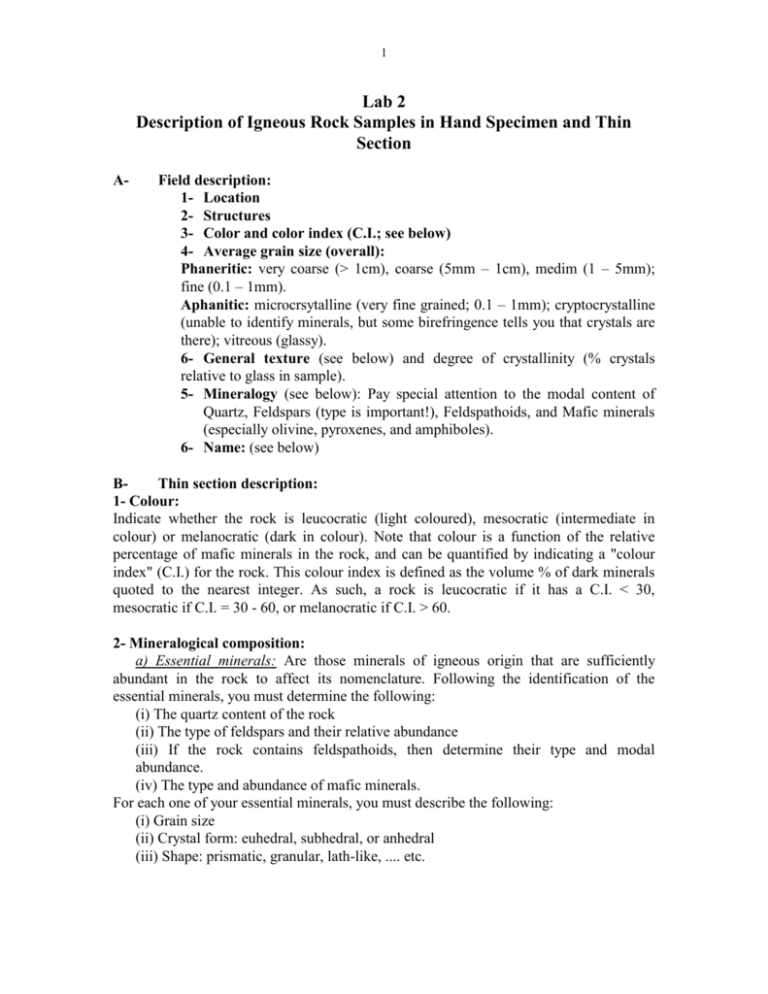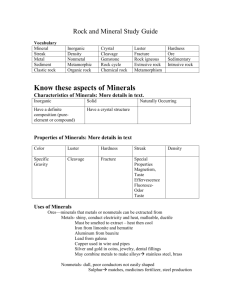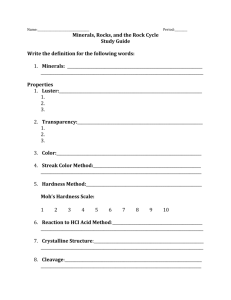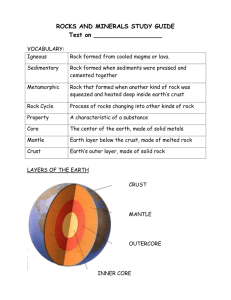Lab 2: Igneous Textures
advertisement

1 Lab 2 Description of Igneous Rock Samples in Hand Specimen and Thin Section A- Field description: 1- Location 2- Structures 3- Color and color index (C.I.; see below) 4- Average grain size (overall): Phaneritic: very coarse (> 1cm), coarse (5mm – 1cm), medim (1 – 5mm); fine (0.1 – 1mm). Aphanitic: microcrsytalline (very fine grained; 0.1 – 1mm); cryptocrystalline (unable to identify minerals, but some birefringence tells you that crystals are there); vitreous (glassy). 6- General texture (see below) and degree of crystallinity (% crystals relative to glass in sample). 5- Mineralogy (see below): Pay special attention to the modal content of Quartz, Feldspars (type is important!), Feldspathoids, and Mafic minerals (especially olivine, pyroxenes, and amphiboles). 6- Name: (see below) BThin section description: 1- Colour: Indicate whether the rock is leucocratic (light coloured), mesocratic (intermediate in colour) or melanocratic (dark in colour). Note that colour is a function of the relative percentage of mafic minerals in the rock, and can be quantified by indicating a "colour index" (C.I.) for the rock. This colour index is defined as the volume % of dark minerals quoted to the nearest integer. As such, a rock is leucocratic if it has a C.I. < 30, mesocratic if C.I. = 30 - 60, or melanocratic if C.I. > 60. 2- Mineralogical composition: a) Essential minerals: Are those minerals of igneous origin that are sufficiently abundant in the rock to affect its nomenclature. Following the identification of the essential minerals, you must determine the following: (i) The quartz content of the rock (ii) The type of feldspars and their relative abundance (iii) If the rock contains feldspathoids, then determine their type and modal abundance. (iv) The type and abundance of mafic minerals. For each one of your essential minerals, you must describe the following: (i) Grain size (ii) Crystal form: euhedral, subhedral, or anhedral (iii) Shape: prismatic, granular, lath-like, .... etc. 2 b) Accessory Minerals: Are those minerals which are not sufficiently abundant in the rock to affect its name. Describe the habit, crystal form and grain size of these minerals only if you think it is important, or for a full detailed report. c) Secondary Minerals: Determine their type and mode of occurrence (e.g. along veins, as alteration products of other primary minerals, .... etc.). 3- Degree of Crystallinity of the Rock: Holocrystalline, hemicrystalline or hyaline (vitreous). 4- Grain Size of the Rock: This is the average grain size of the whole rock, and can be described using the following terms: Aphanitic: which could be microcrystalline, cryptocrystalline, or vitreous (in the case of a hyaline rock) Phaneritic: This term is not widely used anymore. Instead, the actual average grain size of the rock is described (i.e. coarse, medium, fine, or very fine-grained). Note that if the rock has more than one grain size population, you must describe the grain size for each one, e.g. in the case of porphyritic rocks, you must indicate the grain size of the phenocrysts as well as of the matrix! 5- Textures: (a) Describe the textures as you see them under the microscope, and name them with the help of the handout attached, or the "Atlas of Igneous Rocks and Minerals" in the Lab. List all of these textures, indicating clearly which minerals are actually defining each (e.g. Graphic texture defined by the intergrowth between quartz and K-feldspar, Reaction rim texture between pyroxene and amphibole,... etc.). Labelled diagrams are often very helpful, so get yourself in the habit of sketching textural relations. You may also find some interesting textural relations that you cannot name; don't ignore them! Draw and describe these relations as best as you can. When sketching textural relations, remember to draw them to scale, and to put in some sort of a scale bar! (b) Identify the "prevailing" or "general" texture of the sample. 6- Order of Crystallization: One of the main uses of textural relations is the identification of the sequence of mineral crystallization. Use inclusions, crystal shapes, crosscutting relations, ... etc. to infer the order in which minerals crystallized. 7- Full Rock Name: Give the rock its name based on the classification principles that you have learned in the lecture. However, keep in mind that a full name has a few more rules to follow: 1- Indicate the general texture that you think can modify the name of the rock. For example, it is redundant and indeed foolish to say "fine-grained" basalt, since by definition, all basalts are fine-grained, but textures such as "porphyritic" or "amygdaloidal" are indeed important modifiers. 3 2- List the essential minerals that you think will modify the rock name in order of abundance (i.e. the least abundant mineral first). It is foolish to say: "clinopyroxene plagioclase gabbro", since by definition, all gabbros contain Cpx and Plag. Because igneous rock classifications are based mainly on the abundance of quartz, feldspars and feldspathoids, the essential minerals that can modify the name of the rock will be mostly mafic. 3- Indicate the grain size ONLY if the sample is PLUTONIC 4- Write the rock name (from your classification scheme in the lecture notes). 5- For VOLCANIC rocks, you must describe the texture of the groundmass as well. Examples: Porphyritic leucite - clinopyroxene tephrite with a pilotaxitic groundmass. 1 2 4 5 Medium-grained equigranular hypidiomorphic hornblende biotite granodiorite 3 1 2 4 In the first example, Cpx is more abundant than leucite, and in the second, Bt is more abundant than Hb. Types of Textures I- II- III- Equigranular (for plutonic rocks) 1- Panidiomorphic 2- Hypidiomorphic 3- Allotriomorphic Inequigranular (for plutonic and hypabyssal rocks; some terms used with volcanics!) 1- Porphyritic: Types: (a) Glomeroporphyritic (b) Vitrophyric (c) Felsophyric (cryptocrystalline groundmass) (d) Seriate 2- Poikilitic 3- Ophitic 4- Subophitic 5- Diabasic Other Textures: (mostly crystallization textures (c) or subsolidus (ss)) 1- Graphic (c) 2- Granophyric (c) 3- Perthitic (ss) 4- Antiperthitic (ss) 5- Rapakivi (c) 6- Myrmekitic (ss) 4 IV- V- 7- Symplectic intergrowth (ss) 8- Reaction rim 9- Corona 10- Orbicular 11- Zoning (normal, reverse, and oscillatory) 12- Resorption 13- Pleochroic haloes (ss) Groundmass textures (for volcanic rocks) 1- Hyalopilitic 2- Pilotaxitic 3- Orthophyric 4- Intergranular 5- Intersertal Devitrification Textures 1- Felsitic 2- Spherulitic (supercooling) 3- Variolitic 4- Eutaxitic (presence of fiamme) 5- Axiolitic 6- Perlitic (little or no devitrification) Terms useful for describing the general texture of an igneous rock: 1- Equigranular 2- Inequigranular 3- Ophitic 4- Subophitic 5- Pegmatitic 6- Porphyritic 7- Trachytic 8- Vesicular 9- Amygdaloidal 10- Eutaxitic 11- Spherulitic 12- Variolitic 13- Vitreous 5 Lab 2 Textures of Igneous Rocks The following table lists thin section numbers with good examples of the listed textures. Examine these thin sections carefully, making sure you identify the minerals taking part in this textural relation! After you are done with these thin sections, answer the questions on the next page. Texture Porphyritic Glomeroporphyritic Seriate Vitrophyric Trachytic Vesicular Amygdaloidal Intersertal Intergranular Hyalopilitic Pilotaxitic Orthophyric Felsitic Spherulitic Eutaxitic Axiolitic Miarolitic cavities Graphic Myrmekitic Granophyric Perthitic Pegmatitic Aplitic Poikilitic Corona Ophitic Subophitic Symplectic intergrowth Reaction rim Zoning Pleochroic halos Exercises: Thin section # 34, Ig-1 12, SF-18 23, 42 Arco-3 16 34, 9 (pumiceous) 35 36 72-3867, 23, 35 27 21, 36-12 web web 8 Web, Arco-2 web Hand Specimen 1568 4238 7995 5149 1946 4297 3M-3 5092 1 SF-10 SF-2 6, Ig-2 web Ig-1, M-6 33 47 (lab 1) 23 (Bt /Opq); M-6 (Cpx/ Hb) 27, 6(Plag) 2 (in Bt) 8173 7968, 8173 8173 6 1- Based on your observations in this lab, draw labelled diagrams for ten textures of your choice (5 volcanic and 5 plutonic). Be sure to label the minerals taking part in the textural relations you sketch, and to include a scale bar on each diagram. Do not forget to write the sample number (and to include a scale bar)! 2- Give a detailed petrographic description for either sample 4 or sample 7. 3- What is the order of crystallization of minerals in sample 4 or 7? Explain the reasons which led you to arranging the minerals in this order. 4- What is the “full name” of sample 4 or 7?







